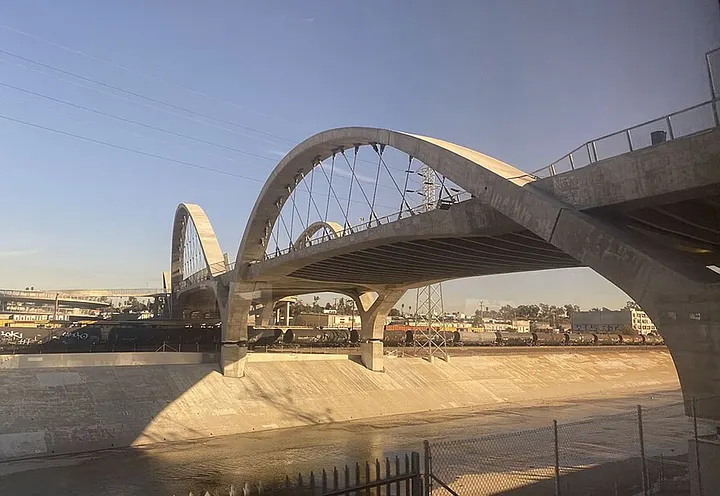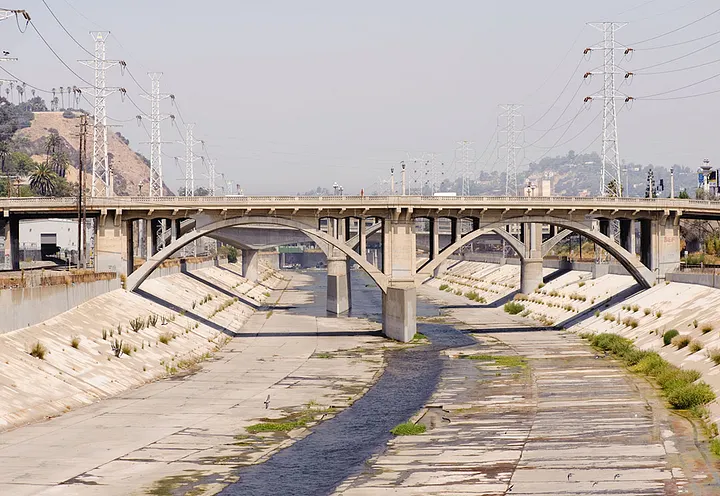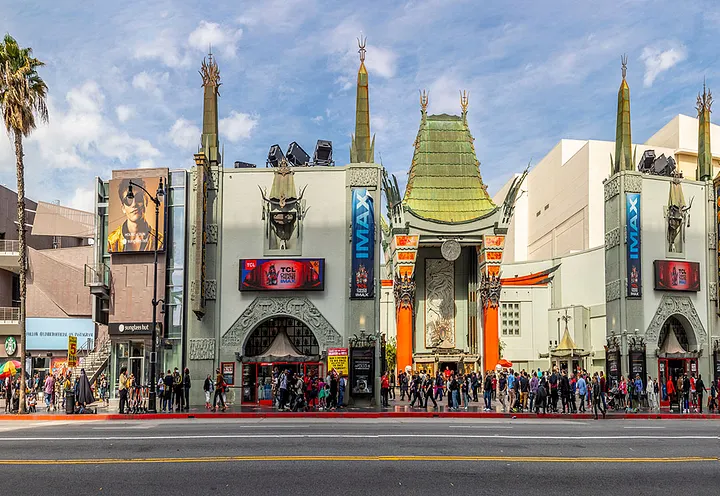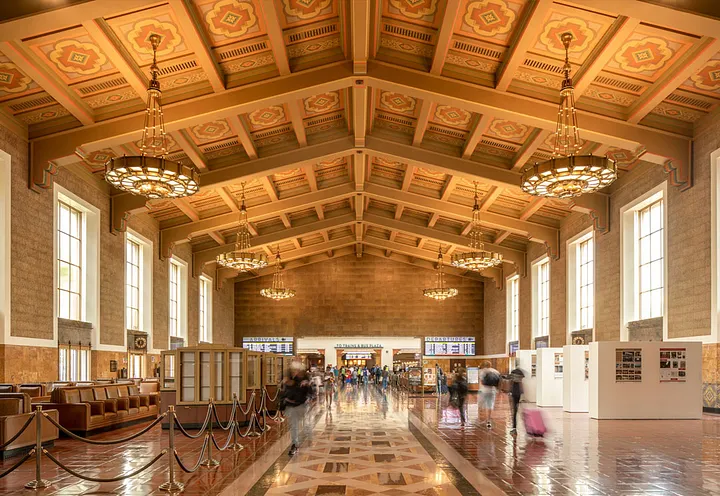LA’s Most-Filmed Locations: A Quick Tour You Can Actually Walk
- TCS Hello
- Aug 20
- 7 min read

Los Angeles is still the capital of on-location filming. Its mix of architecture, neighborhoods, and landscapes has made the city itself a star in thousands of films.
When people think of L.A. on screen, they picture the Hollywood Sign or the Walk of Fame. But the real workhorses are smaller—specific blocks, tunnels, and bridges. These places are so recognizable that they’ve become visual shorthand for the city.
A 2022 study by American Home Shield, which analyzed IMDb filming data, named Hollywood Boulevard the most-filmed street in the U.S. (Source: American Home Shield). But plenty of other spots keep showing up on screen. By looking at IMDb entries, FilmLA permit data, and local reporting, we can map out which blocks get the most attention and why.
How We Picked the Locations
We didn’t guess. We built this list from multiple sources.
Street rankings: The American Home Shield/IMDb study geocoded thousands of film shoots. That gave us hard data on the busiest streets.
What counts as a “block”: A stretch of road with a distinct look—maybe a tunnel, a bridge, or a cluster of buildings that define the shot.
Cross-checking: We checked FilmLA and Los Angeles Times reporting on filming permits, then backed that up with references from guides, Wikipedia, and tourism outlets.
This isn’t a formal study. It’s a curated list of locations that repeatedly appear in films, TV, and commercials.

2nd Street Tunnel (DTLA, Figueroa → Hill)
The 2nd Street Tunnel is one of L.A.’s most filmed landmarks, even if most people don’t know it by name. Its white tile walls and continuous curve make it instantly recognizable to filmmakers.
The tunnel shows up in commercials, car ads, music videos, and blockbusters. Its smooth tile surface and evenly spaced overhead lights create a “light box” effect that’s clean and controlled. That makes it a favorite for futuristic settings or high-speed chase sequences.
It’s appeared in Blade Runner, The Terminator, Kill Bill, Transformers, and Independence Day. Countless car commercials have also been shot here. The sterile design puts all the focus on the car or the actor in frame.
The L.A. Times once called it “the most recognizable city landmark most Americans have never heard of” (Source: Los Angeles Times). Wikipedia lists dozens of credits that show how common it is on screen (Source: Wikipedia).
Directors also like it for practical reasons. It’s downtown, inside the 30-Mile Zone, and easy to close off for controlled shoots. For crews, it’s efficient. For viewers, it’s pure L.A.

6th Street Viaduct (Arts District ↔ Boyle Heights)
The 6th Street Bridge is one of the most iconic film locations in Los Angeles. The original 1932 bridge appeared in Grease, Terminator 2: Judgment Day, Drive, and dozens of music videos. FilmLA data from 2014 logged 86 production days on the old viaduct, making it one of the busiest sites in the city that year (Source: Los Angeles Times).
When the old bridge was demolished in 2016, filmmakers lost a favorite spot. But in 2022, the new “Ribbon of Light” replacement opened. NBC wrote that “Hollywood got its favorite location back” (Source: NBC Los Angeles).
The new design has sweeping arches, pedestrian walkways, and wide roadways that frame the downtown skyline. It’s already appeared in music videos, fashion shoots, and commercials.
The underpasses and surrounding Arts District streets also remain useful for gritty, urban settings. Directors like the contrast: the modern bridge above, the industrial river and warehouses below.
For action scenes, it’s perfect—wide, empty, and cinematic. For establishing shots, it’s unmistakably L.A.

Lower Grand Avenue Underpass (DTLA, 4th → 5th)
Lower Grand is the definition of “moody downtown.” It’s a split-level road with thick concrete beams overhead, shadows cutting across the street, and no storefront clutter. That makes it easy to light, easy to block off, and visually striking.
If you’ve seen The Dark Knight, The Terminator, The Soloist, or countless car ads, you’ve seen Lower Grand. Google Arts & Culture calls out its film pedigree (Source: Google Arts & Culture).
It’s a favorite for student projects and big-budget films alike. The architecture gives scenes scale and depth, whether it’s Batman’s Batmobile roaring down the street or a commercial showing off a sports car.
Directors like it because it looks gritty without needing heavy set design. Crews like it because it’s close to basecamp parking and easy to close for stunts. It’s one of those locations where the look and the logistics line up.

L.A. River (DTLA, 4th–7th Street Bridges)
The concrete channel of the L.A. River is one of the city’s most iconic backdrops. It has appeared in Chinatown, To Live and Die in L.A., Terminator 2: Judgment Day (the truck vs. dirt bike chase), Grease, In Time, and The Italian Job.
Its blank concrete walls, long sightlines, and historic bridges overhead make it cinematic. Crews can use it for car chases, musical numbers, or dramatic stand-offs. The L.A. Times has documented decades of film use there.
FilmLA even calls it “one of the most iconic filming locations in the world.” Part of the appeal is how flexible it is. Directors can frame it as bleak, futuristic, or nostalgic depending on lighting and camera angles.
The surrounding Arts District and Boyle Heights views add more options. From certain points, you see the downtown skyline rising above the river channel, which makes the shot instantly identifiable as Los Angeles.

Hollywood Boulevard (Highland ↔ Vine)
Hollywood Boulevard is the most-filmed street in the United States (Source: American Home Shield). The stretch between Highland and Vine is packed with iconic landmarks: the TCL Chinese Theatre, Dolby Theatre, and blocks of Walk of Fame stars.
This is where red carpets are rolled out for the Oscars, where tourists line up for photos, and where neon marquees light up the night.
On screen, it’s been used in Pretty Woman, La La Land, Once Upon a Time in Hollywood, and hundreds of TV shows and documentaries. Reality crews also shoot here constantly, drawn to the chaos and energy.
Filming here is tough. Crowds, noise, and traffic never stop. But that’s part of the appeal. Directors don’t need to fake Hollywood atmosphere—it’s already there. Discover Los Angeles calls this segment the boulevard’s “marquee zone,” and it’s easy to see why.

Broadway @ 3rd: Bradbury Building Block (DTLA)
The Bradbury Building is one of the most famous film buildings in America. Built in 1893, it has a Romanesque exterior, but inside it reveals a soaring glass atrium with ironwork balconies and vintage elevators.
That interior has appeared in Blade Runner, (500) Days of Summer, The Artist, Chinatown, and Lethal Weapon 4. Discover Los Angeles and Wikipedia both document its long film history (Sources: Discover Los Angeles, Wikipedia).
Directors love it because it can play as both futuristic and historic. The same space can look like a dystopian future city or a romantic throwback, depending on how it’s lit.
Outside, the Broadway streetscape gives filmmakers a slice of DTLA’s Historic Core, with period storefronts and heavy pedestrian activity. Inside, the atrium adds depth, texture, and drama.

Union Station (Alameda & Cesar E. Chávez, DTLA)
Union Station opened in 1939 and is still the largest train terminal in the West. Its Spanish Colonial and Streamline Moderne design makes it one of the most versatile film sites in Los Angeles.
The grand waiting room—with wood-beamed ceilings, Art Deco chandeliers, and long rows of benches—has appeared in Blade Runner, Catch Me If You Can, The Dark Knight Rises, The Soloist, and dozens more.
Directors use it because it can double for airports, banks, courthouses, or generic “grand civic buildings.” It’s been used in noir, romance, action, and sci-fi.
Los Angeles Magazine highlights its long film history, and IMDb analyses rank it among the most-filmed buildings in the U.S. (Sources: Los Angeles Magazine, Explore).
It’s also practical. It sits downtown, has easy loading access, and is inside the 30-Mile Zone. Crews get scale and history without leaving the city core.

Sunset Boulevard (Hollywood ↔ Beverly Hills)
Sunset Boulevard ranked #5 on the list of most-filmed streets in the U.S. (Source: American Home Shield). It runs from downtown all the way to the Pacific, but the busiest segments for filming are in Hollywood, West Hollywood, and Beverly Hills.
The Strip’s neon billboards and music history make it a favorite for nightlife montages. Beverly Hills adds palm-lined streets and mansions that directors use for luxury shots.
Films like Sunset Boulevard, Almost Famous, The Big Lebowski, and Collateral have all used stretches of this road. Music videos and commercials shoot here constantly, taking advantage of its mix of grit and glamour.
It’s long, flexible, and instantly recognizable. For a director who needs a quick way to say “this is Los Angeles,” Sunset is perfect.

Grand Avenue Cultural Core (DTLA)
Grand Avenue between 1st and 3rd Streets offers some of L.A.’s most modern backdrops. The Walt Disney Concert Hall, designed by Frank Gehry, provides stainless steel curves that bounce light dramatically. The Museum of Contemporary Art (MOCA) and The Broad add sharp lines and minimalist plazas.
The L.A. Times has noted this area’s popularity with filmmakers. It’s been used in sci-fi, music videos, car commercials, and high-fashion ads.
The appeal is obvious: it looks like the future. Directors don’t need to build elaborate sets when the architecture is already there.

Why These Locations Work
These locations get booked for two main reasons: they look good, and they’re practical.
They’re visually clear: tunnels, bridges, and boulevards that read “Los Angeles” right away.
They’re easy to control: underpasses and tunnels can be closed for stunts and big equipment.
They’re inside the 30-Mile Zone: union rules make locations within this radius cheaper and easier to permit (Source: California Film Commission).
They’re covered by FilmLA: one central office handles permits for most L.A. shoots (Source: FilmLA).
Living on a Filmed Block
Owning property on one of these streets comes with trade-offs.
Pros: Your block is recognizable worldwide. Sometimes owners get paid location fees. These areas are often well-kept and in demand.
Cons: Filming can disrupt daily life with lights, noise, and street closures. (Source: FilmLA).

Final Thoughts
These blocks aren’t just backdrops. They’re part of how the world sees Los Angeles. From tunnels and riverbeds to grand stations and neon boulevards, each location has become part of Hollywood’s visual language. They keep showing up because they balance looks and logistics. They’re striking on camera but also practical for crews. That’s what brings directors back, decade after decade. For residents, the experience is mixed. There’s pride in seeing your block on screen, but also disruption when the lights and cameras roll.
Either way, these places remind us that in Los Angeles, the city itself is always part of the story.




Comments